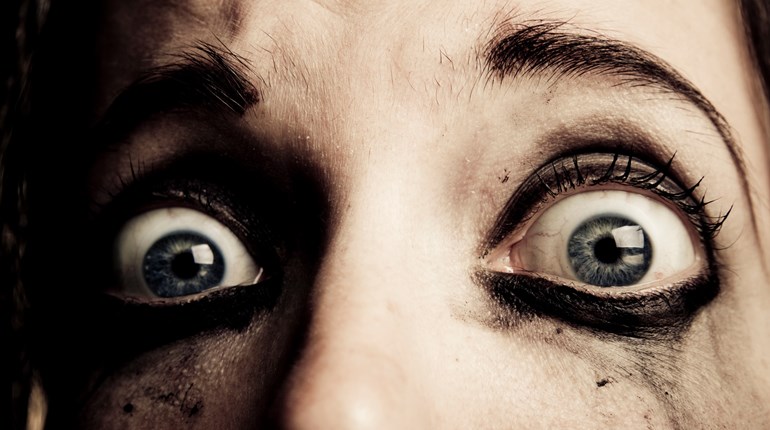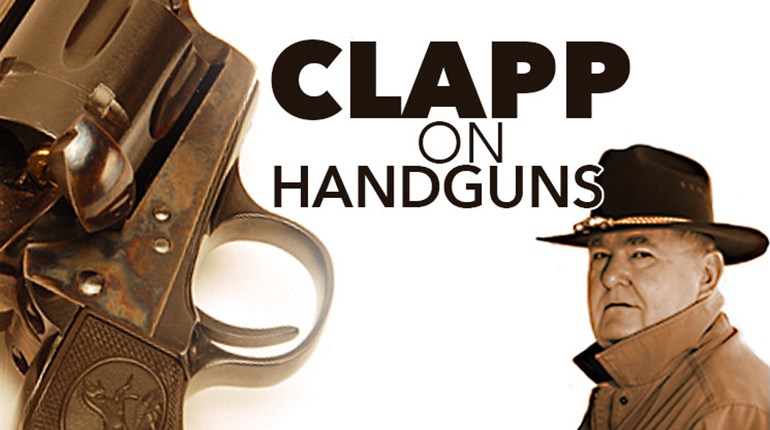
I learned to shoot on my grandfather’s land with a single-shot, bolt-action .22 LR altered to fit a five-year-old’s body. It’s likely then that I was told the first myth about shooting accurately: “Always press the trigger straight back.” Stand on any firing line, and you’ll hear a shooter’s trigger press being blamed for inaccuracies.
Since the beginning of time and forever after, the mantra of a “straight-back” trigger press has been expounded and repeated, pounded into every shooter’s psyche. It spawned an entire industry of index-finger-movement worship, philosophy and lore. The proper finger placement on the trigger, perpendicular pressure on the face of the trigger and “Don’t disturb the sights when pressing the trigger straight back” are mandatory instructional content.
What if it is all a bunch of hooey and simply a never-to-be-questioned, cherished myth? What if those gifted individuals who are tremendously quick and accurate in handgun shooting listened to the same directions we were all given, but inadvertently arrived at a different destination than the rest of us? Is it possible those successful shooters may not even know it, thinking they are pressing the trigger straight back with their triple-hinged trigger fingers rather than attributing it to a proper grip on their firearms?
Now that you’re likely questioning my sanity, let’s dive into my reasoning. The trigger finger consists of three bones with three joints (OK, four bones if you count the metacarpal from which the finger hinges). Think of these joints as hinges, like the hinges of a gate, permitting the finger to flex and extend through an arc. Now, hold your index finger straight up in front of you and press an imaginary trigger. How many arcs of travel are there acting upon every trigger press? I count three, with the tip of the finger moving through the greatest arc. Notice that each arc of a single joint affects the travel of the other two. Do it again while asking yourself, “exactly where does my trigger finger move in a straight line backward?”
Dominant trigger-press dogma requires us to place the center of the pad of the tip of our finger on the trigger, and then depress the trigger directly in line with the muzzle—or straight back—through those three arcs of movement without disturbing the sights’ alignment on the target. How do we translate three arcs of travel while pressing a hinged lever into straight-back movement long enough to prevent disturbing the sights? The answer? The anatomy and physics say we can’t. So, something else must be involved when shooting accurately other than a straight-back trigger press.
Let’s break down how to arrive at a reproduceable trigger press that consistently helps us get the results we want: accurate hits. Could it be that a proper grip creates a proper trigger press, exactly the reverse from what we’re taught?

When we fire any firearm, recoil results. As Massad Ayoob teaches, there are three forces of recoil we must overcome while firing a handgun: 1) Straight back, in reaction to the forces causing the bullet to move through the bore; 2) Muzzle flip, due to the skeletal structure of the hand located below the bore axis of the barrel; and 3) Lateral flip, caused by the mass of the shooting hand on one side being greater than the mass of the fingers gripping the handgun on the other. Shooting one-handed, we experience the handgun pushing back while the muzzle flips up as the handgun tips to the side opposite the palm of the hand holding the pistol.
Using any part of the trigger finger—from the fingertip to the second joint—to press the trigger works as long as the “thumb presses the trigger.”
Using one or both hands during the shooting process is a function of contextual need at that moment. For pure accuracy, target-shooting records are accomplished one-handed, as there is no need for maximizing recoil management. If there is a practical need to quickly reacquire the sights for rapid subsequent shots, a two-handed grip assists in preventing excessive recoil movement of the handgun as it fires.
We’re going to focus for a moment on both number 1, straight back, and number 2, muzzle flip during recoil, which coincidentally creates the ability to have a consistently repeatable trigger press. The handgun is roughly “L-shaped,” with the grip on the short leg of the L. If the end (muzzle) of the long leg of the L (the slide of a pistol held horizontally) rises, the end of the short leg rotates forward and up, hinging at the point where the two legs join. To overcome muzzle flip while holding the grip of the L-shaped handgun, pressure must be placed as high as possible on the rear, or backstrap, of the grip, while simultaneously placing equal pressure as low as possible and to the front, or the frontstrap, of the grip.
In a proper grip with the trigger finger indexed (kept straight off the trigger and touching the slide-frame junction), the palm just below the base of the thumb (technically, the thenar eminence) of your shooting hand is pressed as high as possible on the pistol’s backstrap. Your middle, ring and little fingers grip the handgun frontstrap, pressing up against the trigger guard. The emphasis is on your ring finger (the strongest finger when gripping). The shooting hand’s fingers (ring finger-focused) and palm below the base of the thumb tightly grip the pistol’s grip in a “fore-and-aft” manner. Different than gripping a claw hammer where the grip provides 360 degrees of pressure on every surface of the handle, the fingers press the frontstrap back while the palm at the base of the thumb presses the backstrap forward.

The shooting-hand thumb itself does not hold the pistol at all, but intentionally and purposely extends toward the target. This action of tight fore-and-aft pressure locks the shooting hand’s wrist, preventing significant rotation of the handgun, largely controlling both muzzle flip and straight-back recoil.
For a two-handed grip, the support hand slides up from under the pistol, with the swell of the thumb as high as practicable on the grip with the palm of the hand in contact, thumb pressing forward toward the muzzle. With the index finger jammed up into the trigger guard, all four fingers wrapping over the shooting hand’s fingers, the pressure is on the sides of the grip, with the fingertips (emphasis again on the ring finger) and palm squeezing as if attempting to press the sides of the grip together. With the support-hand high on the grip under the shooting thumb, this helps overcome the lateral flip during recoil. There should be no space between the support-hand and the shooting hand on the grip. This creates a “360-degree grip,” resulting in fore-and-aft pressure from the shooting hand and side-to-side pressure from the support hand, with both wrists locked.
There’s another dogma and cherished belief about the grip from the days of yesteryear preventing a proper grip and detrimental to a consistent trigger press. We were taught to hold the pistol with the same pressure as a “business handshake.” When held just firmly, it makes sense that a trigger press will disturb sight alignment. Today’s handgun grip is much tighter than that, just below the threshold of causing tremors. You’ll know there’s too much pressure if the front sight seems “more nervous” than usual (it moves more). Focus on the palm below the thumb and ring finger of both hands pressing tightly in their respective directions.
For a two-handed grip, the support hand slides up from under the pistol, with the swell of the thumb as high as practicable on the grip with the palm of the hand in contact, thumb pressing forward toward the muzzle.
Imagine the index finger squeezing to the base of the thumb: The first metacarpal, or the bone of the hand where the thumb attaches to the shooting hand, is pressed tightly against the backstrap, while the tip of the thumb reaches as far as possible forward, cementing that part of the palm high against the pistol’s backstrap. “Pressing the trigger with the thumb” changes the mechanics of the index finger during trigger press. Not to get too new-agey about it (cue the gongs and incense), there is a “relationship” between the base of the shooting thumb positively affecting the strength and movement of the index finger.
The placement of the trigger finger on the trigger has proven to be unimportant as long as the base of the thumb is pressed solidly against the top of the backstrap while the mental image of “pressing the trigger with my thumb” is maintained. Using any part of the trigger finger—from the fingertip to the second joint—to press the trigger works as long as the “thumb presses the trigger.” Whatever part of the finger naturally touches the trigger is “proper.” Because we’re all different, other mental images like, “reach as far forward with the tip of your thumb toward the muzzle and then press the trigger,” or, “Press your trigger to the base of your thumb,” also work for some shooters.
For novice shooters, pressing their triggers “with their thumbs” helps them achieve rapid success because they begin with a proper grip, locking the wrist and hand(s), setting the stage at the very beginning for accurate fire. This alone eliminates a huge degree of mental clutter in learning to shoot accurately.
When introducing this idea to experienced shooters, there is a rapid progression of extreme cynicism, then questioning, followed by experimentation, which generally quickly transitions to surprise, then near-messianic zeal. However, old habits are hard to break and often requires the shooter to engage in much conscious dry practice to overcome a lifetime’s experience. During live fire on the range, it’s not unusual for old habits to rear up and begin throwing rounds. Repeating, “Front sight, press the trigger with the thumb,” is often a quick cure, leading to greater accuracy.
Being old, I’ve experienced many iterations of what constituted a “proper grip,” but never anything but a single “proper” way to press a trigger: straight back. It’s important to challenge our beliefs and dogmas to discover those cherished myths we uncritically accepted because “that’s how it’s always been done.” Age doesn’t always equal wisdom. It took me a long time to figure out that I was not alone with trigger-control struggles. However, I’m experienced enough to know when something finally works consistently, it’s time to stick with it. When my grip is right and I press the trigger with my thumb, my trigger press causes the bullet to do what I want it to do. Give it a try. It may work for you.




































